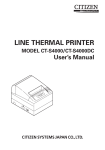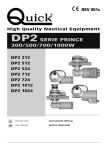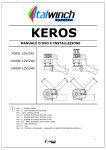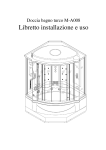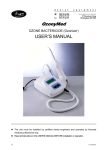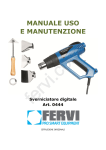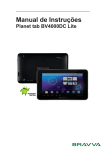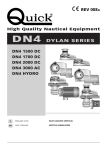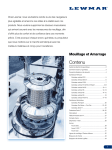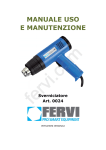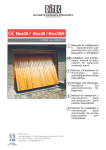Download 26 giugno 2014 - Rev. 000 A XR7 - XROY Series
Transcript
REV 000a PRELIMINARE PRELIMINARY High Quality Nautical Equipment XR7XROY SERIES XR7 XR7 XR7 XR7 4024 DC 4000 AC 5500 AC HYDRO IT Manuale d'uso SALPA ANCORA VERTICALI GB User's Manual VERTICAL WINDLASSES IT INDICE Pag. 4 Pag. 5 Installazione Pag. 6 Schema di collegamento XR7 4000W DC Pag. 7 Pag. 8/9 Caratteristiche tecniche / Installazione Schema di collegamento XR7 4000/5500W 400V AC Manutenzione Pag. 10 Avvertenze importanti - Uso Pag. 11 Uso Pag. 12 Salpa ancora idraulico: caratteristiche tecniche - installazione Pag. 13 Salpa ancora idraulico: schema di collegamento GB INDEX Pag. 14 Technical data / Installation Pag. 15 Installation Pag. 16 Connection diagram XR7 4000W DC Pag. 17 Connection diagram XR7 4000/5500W 400V AC Pag. 1 8/19 Maintenance Pag. 20 Warning - Usage Pag. 21 Usage Pag. Hydraulic windlass: technical data - installation 22 Pag. 23 Hydraulic windlass: connection diagram XR7 4000/5500/HY - IT GB - REV000A 3 CARATTERISTICHE TECNICHE - INSTALLAZIONE IT COME SI LEGGE IL MODELLO DEL SALPA ANCORA: 40 24 X a a a a XR7 a ESEMPIO: XR74024X a b c e b Nome della serie: [ XR7 ] = base e campana in acciaio inox AISI 316 c Potenza motore: [ 40 ] = 4000 W [ 55 ] = 5500 W MODELLO POTENZA MOTORE e Tensione motore: [ 24 ] = 24 V [ TR ] = 230/400 V Passacatena: [ X ] = passacatena destro [ Y ] = passacatena sinistro XR7 4000 X/Y 4000 W Tensione motore 24 V Tiro istantaneo massimo 4000 Kg (8818 lb) Carico di lavoro massimo 1500 Kg (3307 lb) Carico di lavoro 700 Kg (1543 lb) Assorbimento corrente al carico di lavoro (1) 190 A Velocità massima di recupero (2) 29 m/min (95,1 ft/min) Velocità di recupero al carico di lavoro (2) 15 m/min (49,2 ft/min) Sezione minima cavi motore (3) 35 mm2 (AWG 2) Interruttore di protezione (4) 40 A Spessore coperta (5) 30 ÷ 60 mm (1” 3/16 ÷ 2” 5/16) Peso 170 kg (375 lb) MODELLI POTENZA MOTORE XR7 AC 4000 X/Y 4000 W TR Tensione motore Tiro istantaneo massimo Carico di lavoro massimo Velocità massima di recupero (2) XR7 AC 5500 X/Y 5500 W TR 230/400 V 230/400 V 4000 Kg (8818 lb) 4500 Kg (8818 lb) 2000 Kg (4409 lb) 2350 Kg (5181 lb) 12,5 m/min (41 ft/min) 12,5 m/min (41 ft/min) Spessore coperta (5) 30 ÷ 60 mm (1” 3/16 ÷ 2” 5/16) Peso 180 kg (397 lb) 185 kg (408 lb) • (1) Dopo un primo periodo d'uso. • (2) Misure effettuate con barbotin per catena da 14 mm. • (3) Valore minimo consigliato per una lunghezza totale L= <20m. Calcolare la sezione del cavo in funzione della lunghezza del collegamento. • (4) Con interruttore specifico per correnti continue (DC) e ritardato (magneto-termico o magneto-idraulico). • (5) Su richiesta possono essere forniti prigionieri per spessori di coperta maggiori. BARBOTIN 12,5 mm 14 mm 16 mm Catena supportata 12,5 mm STUDLINK 14 mm STUDLINK 16 mm STUDLINK INSTALLAZIONE PRIMA DI UTILIZZARE IL SALPA ANCORA LEGGERE ATTENTAMENTE IL PRESENTE MANUALE D'USO. IN CASO DI DUBBI CONSULTARE IL RIVENDITORE QUICK®. ATTENZIONE: i salpa ancora Quick® sono stati progettati e realizzati per salpare l'ancora. Non utilizzare questi apparecchi per altri tipi Quick® non si assume alcuna responsabilità per i danni diretti o indiretti causati da un uso improprio dell'apparecchio. di operazioni. Il salpa ancora non è progettato per sostenere carichi generati in particolari condizioni atmosferiche (burrasca). Disattivare sempre Accertarsi che non vi siano bagnanti nelle vicinanze prima di calare l’ancora. Per maggiore il salpa ancora quando non è in uso. Consigliasicurezza, nel caso in cui uno si danneggi suggeriamo di installare almeno due comandi per l’azionamento del salpa ancora. mo l’uso dell’interruttore magneto-idraulico Quick® come sicurezza per il motore. Bloccare la catena con un fermo prima di partire La scatola teleinvertitori deve essere installata in un luogo protetto da possibili entrate d’acqua. Dopo aver per la navigazione. Per prevenire rilasci non voluti l’ancora deve completato l’ancoraggio, fissare la catena o cima a punti fissi quali chian stopper o bitta. Isolare il salpa ancora dall’impianto elettrico durante essere fissata, il salpa ancora non deve essere usato come unica presa di forza. la navigazione (disinserire l’interruttore di protezione del motore) e bloccare la catena ad un punto fisso dell’imbarcazione. LA CONFEZIONE CONTIENE: salpa ancora (top + motoriduttore) - cassetta teleinvertitori (XR7 4000W DC) - dima di foratura - leva viterie (per l'assemblaggio) - manuale di istruzioni - condizioni di garanzia. F Quick® si riserva il diritto di apportare modifiche alle caratteristiche tecniche dell'apparecchio e al contenuto di questo manuale senza alcun preavviso. In caso di discordanze o eventuali errori tra il testo tradotto e quello originario in italiano, fare riferimento al testo italiano o inglese. 4 XR7 4000/5500/HY - IT GB - REV000A INSTALLAZIONE IT ATTREZZI NECESSARI PER L'INSTALLAZIONE: trapano con punta: Ø 15 mm (19/32"); a tazza Ø 200 mm (7" 7/8); chiave esagonale: 17 e 19 mm. ACCESSORI QUICK® CONSIGLIATI: cassetta per collegamenti elettrici per motori AC (EC-Box40/55) - Comando da plancia (mod. 800) - Pulsantiera stagna (mod. HRC 1002) - Pulsante a piede (mod. 915C) - Interruttore magneto-idraulico (mod. 10150) - Conta catena per l'ancoraggio (mod. CHC 1102M e CHC 1202M) - Sistema di comando via radio RRC (mod. R02, P02, H02). REQUISITI PER L'INSTALLAZIONE: il salpa ancora va posizionato allineando il barbotin con il puntale di prua. Verificare che le superfici superiore e inferiore della coperta siano più parallele possibili; se ciò non dovesse accadere compensare opportunamente la differenza (la mancanza di parallelismo potrebbe causare perdite di potenza del motore). Lo spessore di coperta dovrà essere compreso fra i valori indicati in tabella. Se si avessero spessori differenti è necessario consultare il rivenditore Quick®. Non devono esistere ostacoli sotto coperta per il passaggio della catena, la poca profondità del gavone potrebbe provocare inceppamenti. max 5 mm (3/16") 90° 90° minimo 1m (39”3/8) 90° RIFERIMENTO NUMERI A PAG. 8/9 PROCEDURA DI MONTAGGIO A) stabilita la posizione ideale praticare i fori utilizzando la dima di foratura fornita a corredo. B) Rimuovere il materiale in eccesso dal foro di passaggio della catena, rifinirlo e lisciarlo con un prodotto specifico (vernice marina, gel o resina epossidica) assicurando il libero passaggio della catena. C) Posizionare la parte superiore del salpa ancora. D Fissarlo avvitando i dadi sui prigionieri di bloccaggio. E) Inserire l’o-ring (38) nella flangia (42). F) Fissare la flangia all’inserto base (35) tramite 6 viti (44). G) Inserire il motoriduttore nell’albero del salpa ancora. H) Serrare con viterie (39 - 40 - 41). Collegare i cavi di alimentazione provenienti dal salpa ancora al teleinvertitore (DC) o all’alimentazione di rete (AC). C PRIGIONIERO (48) RONDELLA (49) GROWER (50) DADO (51) O-RING (38) FLANGIA (42) 180 Nm F INSERTO BASE (35) D E VITE (44) 45° A B VITE (39) RONDELLA (40) GROWER (41) ATTENZIONE: prima di effettuare il collegamento accertarsi che non sia presente l'alimentazione su cavi. XR7 4000/5500/HY - IT GB - REV000A H G 5 SCHEMA DI COLLEGAMENTO IT SISTEMA BASE XR7 4000W DC ACCESSORI QUICK® PER L'AZIONAMENTO DEL SALPA ANCORA PULSANTIERA CONTACATENA MOD. CHC 1102 M PULSANTIERA MULTIUSO MOD. HRC 1002 COMANDO DA PLANCIA MOD. 800 CONTACATENA DA PANNELLO MOD. CHC 1202 M RADIOCOMANDI RRC TRASMETTITORI SALPA ANCORA RICEVITORE MOD. R02 TASCABILE MOD. P02 PULSANTIERA MOD. H02 MOTORE BLU NERO A1 A2 D1 D2 MARRONE PULSANTI A PIEDE MOD. 915C NERO MARRONE L5 BLU BATTERIA FUSIBILE 2A (24V) L1 INTERRUTTORE MAGNETO IDRAULICO (vedi tabella pag.4) L3 L2 L4 CASSETTA TELEINVERTITORI MOD. T6415-24 (24V) L6 A2 C A1 L = L1 + L2 + L3 + L4 + L5 + L6 6 XR7 4000/5500/HY - IT GB - REV000A SCHEMA DI COLLEGAMENTO TRIFASE IT SISTEMA BASE XR7 4000/5500W 400V AC CONTACATENA PER ANCORAGGIO MOD. CHC1202 M PULSANTIERA CONTACATENA MOD. CHC1102 M PULSANTIERA MULTIUSO MOD. HRC1002 COMANDO DA PLANCIA MOD. 800 RADIO RECEVITORE RRC MOD. R02 (2CH) PULSANTI A PIEDE MOD. 915C UP + - DOWN BLU MARRONE NERO BLU MARRONE NERO + - UP DOWN SENSORE CAN L CAN H GRIGIO ROSSO VERDE MARRONE BIANCO BLU NERO BLU MARRONE NERO 150 CAN L CAN H CAN L CAN H BATTERIA 24V XP T L2 XP S L1 XP R FU1 8 -16A aM T FU1 8 -16A aM S FU1 8 -16A aM R KM1 24V PE V1 U1 24V KM2 W1 L3 XP R XP U1 S XP V1 T XP W1 SALPA ANCORA SENSORE W2 U2 V2 U1 V1 W1 MOTORE 400V CA Max 4,0KW / 5,5KW M 1~ MORSETTIERA XR7 4000/5500/HY - IT GB - REV000A 7 MANUTENZIONE IT 1 2 3 4 5 6 32 7 33 34 34 8 35 9 10 36 11 12 13 19 20 14 21 22 23 24 26 15 25 25 31 16 27 29 29 30 37 37 34 34 17 18 28 33 32 48 49 50 51 8 XR7 4000/5500/HY - IT GB - REV000A MANUTENZIONE IT N°. DENOMINAZIONE 20 Staccacatena serie XR7 40 Grower 1 Leva in alluminio 21 Vite 41 Rondella 2 Vite 22 Supporto staccacatena XR7 42 Flangia riduttore 3 Bussola campana XR7 23 Perno ottone M16 XR7 43 O-ring 4 Disco campana XR7 24 Perno ottone XR7 44 Vite 5 Anello antirotazione 25 Anello elastico esterno 45 Riduttore TG130 6 Anello elastico esterno 26 Freno a fascia serie XR7 46 Flangia chiusura riduttore XR7 TG130 7 Molla 27 Volantino freno remoto 47 Vite 8 Campana salpa Ø 250 XR7 28 Asta freno remoto 48 Prigioniero 9 Distanziale disco campana XR7 29 Spina elastica dritta 49 Rondella 10 Vite 30 Giunto cardanico 50 Grower 11 Paraolio 31 Albero freno fascia 51 Dado 12 Anello elestico esterno 32 Paraolio 52 Chiavetta 13 Anello antirotazione 33 Anello elastico interno 53 Adattatore 14 Barbotin 34 Cuscinetto 54 Flangia Motore 3000W 15 Rondella di rinforzo 6000W 35 Inserto base XR7 55 Chiavetta 16 Vite 36 Albero salpa serie XR7 56 Motore 3000W 24V 17 Porta sensore cilindrico 37 Anello elastico esterno 57 Motore 4,0KW 18 Base salpa serie XR7 38 O-ring 58 Motore 5,5KW 19 Vite svasata 39 Vite 52 ATTENZIONE: accertarsi che non sia pre- sente l'alimentazione al motore elettrico quando si opera manualmente sul salpa ancora; rimuovere con cura la catena o cima dal barbotin o la cima dalla campana. I salpa ancora Quick® sono costituiti da materiali resistenti all'ambiente marino: è indispensabile, in ogni caso, rimuovere periodicamente i depositi di sale che si formano sulle superfici esterne per evitare corrosioni e di conseguenza danni all'apparecchio. Lavare accuratamente con acqua dolce le superfici e le parti in cui il sale può depositarsi. 38 58 52 39 40 41 42 Smontare una volta all'anno il barbotin e la campana attenendosi alla seguente sequenza: 43 Pulire ogni parte smontata affinché non si verifichino attacchi di corrosione e ingrassare (con grasso marino) il filetto dell'albero (36) e il barbotin (14). 44 45 57 52 55 Rimuovere eventuali depositi di ossido sui morsetti della cassetta teleinvertitori; cospargerli di grasso. 53 43 46 54 56 47 XR7 4000/5500/HY - IT GB - REV000A 9 IT AVVERTENZE IMPORTANTI - USO AVVERTENZE IMPORTANTI ATTENZIONE: non avvicinare parti del corpo o oggetti alla zona in cui scorrono catena, cima e barbotin. Accertarsi che non sia presente l'alimentazione al motore elettrico quando si opera manualmente sul salpa ancora (anche quando si utilizza la leva per allentare la frizione); persone dotate di comando a distanza del salpa ancora (pulsantiera remota o radiocomando) potrebbero accidentalmente attivarlo. ATTENZIONE: bloccare la catena con un fermo prima di partire per la navigazione. ATTENZIONE: non attivare elettricamente il salpa ancora con la leva inserita nella campana. ATTENZIONE: Quick® consiglia di utilizzare una protezione tipo fusibile/magnetotermico/magnetoidraulico di potenza adeguata a seconda del motore utilizzato per salvaguardare il motore da surriscaldamenti o corto-circuiti. L’interruttore può essere utilizzato per isolare il circuito di comando del salpa ancora evitando così azionamenti accidentali. USO TRASMISSIONE DI POTENZA L’asse centrale è connesso al riduttore e alla campana. Il barbotin viene trascinato dalla campana tramite innesti frontali sul barbotin. Quando la campana (8) è alta (Fig. A) e la bussola (3) completamente svitata, il barbotin (14) è libero. Quando la campana è bassa (Fig. B) e la bussola (3) completamente avvitata, il barbotin (14) è connesso all’asse tramite la campana e si può salpare l’ancora. INNESTO DEL BARBOTIN 1) Tramite la leva (1) avvitare ruotando in senso orario la bussola 3); la campana (8) si abbassa ingaggiando il barbotin (14). La bussola non deve essere troppo stretta, in questo modo permetterà alla campana di ruotare sul barbotin e ingaggiare gli innesti frontali tramite le molle (7). 2) Tramite la leva (1) svitare ruotando in senso antiorario la bussola di 1/4 di giro. 3) Rimuovere la leva. 4) Azionare il motore. Le molle (7) presenti nella bussola faranno ingaggiare gli innesti frontali tra campana e barbotin. 5) Assicurarsi visivamente dell’avvenuto innesto (Fig. B) e avvitare in senso orario la bussola. 6) Rimuovere la leva. 7) Allentare il freno a fascia (26) nel caso si debba utilizzare il salpa. RECUPERO DELL’ANCORA CON MOTORE 1) Assicurarsi che la campana sia innestata al barbotin (Fig. B). 2) Agire sui comandi Quick® per salpare o rilasciare l’ancora. CADUTA LIBERA (FREE FALL) 1) Assicurarsi che il chain stopper Quick® sia in posizione di NON blocco della catena (Fig. C). 2) Assicurarsi che il freno a fascia (26) sia completamente stretto. 3) Svitare in senso antiorario la bussola fino al suo fine corsa e assicurarsi che la campana sia alta, disinnestata dal barbotin (Fig. A). 4) Agire sul volantino per allentare il freno a fascia (26) e regolare la caduta libera (free fall) dell’ancora. USO DELLA CAMPANA (BARBOTIN BLOCCATO) 1) Assicurarsi che il chain stopper Quick® sia in posizione di blocco della catena (Fig. D). 2) Assicurarsi che il freno a fascia (26) sia completamente stretto. 3) Svitare in senso antiorario la bussola fino al suo fine corsa e assicurarsi che la campana sia alta, disinnestata dal barbotin (Fig. A). 4) Agire sui comandi Quick® per far ruotare la campana in un senso o nell’altro (Fig. E). Avvolgere la cima alla campana in senso antio- rario (almeno 3 giri - fig. F). La riduzione della velocità e della forza di recupero possono essere regolate facendo scorrere la cima sul tamburo della campana. ATTENZIONE: durante il recupero, mantenere un’adeguata distanza di sicurezza tra mani e campana salpa ancora. 10 XR7 4000/5500/HY - IT GB - REV000A USO IT FIG. B FIG. A 1 3 1 8 3 8 14 14 FIG. C FIG. D FIG. E FIG. F RADIOCOMANDI QUICK® XR7 4000/5500/HY - IT GB - REV000A 11 SALPA ANCORA IDRAULICO IT MODELLO IDRAULICO XR7 HYDRO X/Y Tipologia motore Reversibile ad ingranaggi Cilindrata 22 cc 1,34 in3 • 100 bar = 1400 kg • 210 bar = 3000 kg • 1450.4 psi = 3087 lb • 3045 psi = 6614 lb 50 lt /min = 12,5 mt/min 11,4 USG/min = 41 ft/min 30 ÷ 60 mm 1” 3/16 ÷ 2” 23/64 inch 165 kg 363,8 lb Portata 50 lt/min 11,4 USG/min Pressione massima 210 bar 3045 psi Capacità di sollevamento Velocità di recupero al carico di lavoro (1) Spessore coperta (2) Peso VALORI DI REGOLAZIONE (consigliati da Quick) (1) Misure effettuate con barbotin per catena da 14 mm. (2) Su richiesta possono essere forniti prigionieri per spessori di coperta maggiori. LA CONFEZIONE CONTIENE: salpa ancora idraulico (top + motoriduttore) - dima di foratura - leva - viterie (per l'assemblaggio) manuale di istruzioni - condizioni di garanzia. ATTREZZI NECESSARI PER L'INSTALLAZIONE trapano con punta: Ø 15 mm (19/32"); a tazza Ø 200 mm (7" 7/8); chiave esagonale: 17 e 19 mm. ACCESSORI QUICK® CONSIGLIATI: comando da plancia (mod. 800) - Pulsantiera stagna (mod. HRC 1002) - Pulsante a piede (mod. 915C) - Conta catena per l'ancoraggio (mod. CHC 1102M e CHC 1202M) - Sistema di comando via radio RRC (mod. R02, P02, H02). PROCEDURA DI MONTAGGIO A) Stabilita la posizione ideale praticare i fori utilizzando la dima di foratura fornita a corredo (vedi figura pag. 5). B) Rimuovere il materiale in eccesso dal foro di passaggio della catena, rifinirlo e lisciarlo con un prodotto specifico (vernice marina, gel o resina epossidica) assicurando il libero passaggio della catena (vedi figura pag. 5). C) Posizionare la parte superiore del salpa ancora, D) fissarlo avvitando i dadi sui prigionieri di bloccaggio. E) Inserire l’o-ring (38) nella flangia (42). F) Fissare la flangia all’inserto base (35) tramite 6 viti (44). G Inserire il motoriduttore nell’albero del salpa ancora. H) Serrare con viterie (39 - 40 - 41). I) Collegare i tubi provenienti dalla valvola distributrice alle due flangette del motore idraulico (vedi schema di collegamento a pag.13). RIFERIMENTO NUMERI A PAG. 8/9 C PRIGIONIERO (48) RONDELLA (49) D VITE (39) RONDELLA (40) GROWER (41) GROWER (50) 180 Nm DADO (51) F INSERTO BASE (35) VITE (44) O-RING (38) FLANGIA (42) E 90° G 90° 90° 90° F 12 H I Quick® si riserva il diritto di apportare modifiche alle caratteristiche tecniche dell'apparecchio e al contenuto di questo manuale senza alcun preavviso. In caso di discordanze o eventuali errori tra il testo tradotto e quello originario in italiano, fare riferimento al testo italiano o inglese. XR7 4000/5500/HY - IT GB - REV000A SALPA ANCORA IDRAULICO IT ACCESSORI QUICK® PER L’AZIONAMENTO DEL SALPA ANCORA IDRAULICO SISTEMA BASE XR7 IDRAULICO SCHEMA DI COLLEGAMENTO CONTACATENA DA PANNELLO CHC 1202 M PULSANTIERA MULTIUSO MOD. HRC 1002 PULSANTIERA CONTACATENA MOD. CHC 1002 M COMANDO DA PLANCIA MOD.800 PULSANTI A PIEDE MOD. 915 C RADIOCOMANDI RRC TRASMETTITORI RICEVITORE MOD. R02 TASCABILE MOD. P02 PULSANTIERA MOD. H02 VALVOLA DISTRIBUTRICE INGRESSO PRESSIONE SERBATOIO MOTORE IDRAULICO 52 53 POS. DENOMINAZIONE 52 Chiavetta 53 Adattatore 54 Flangia motore idraulico 59 Motore idraulico 60 Flangetta 90° G3/4 femmina 54 59 XR7 4000/5500/HY - IT GB - REV000A 60 13 TECHNICAL DATA GB HOW TO IDENTIFY THE WINDLASS THROUGH THE CODE: 40 24 X a a a a XR7 a EXAMPLE: XR74024X a b c e b Name of the line: [ XR7 ] = stainless steel AISI 316 base and drum c Motor power: [ 40 ] = 4000 W [ 55 ] = 5500 W MODEL MOTOR POWER e Motor supply voltage: [ 24 ] = 24 V [ TR ] = 230/400 V Chain pipe: [ X ] = right chain pipe [ Y ] = left chain pipe XR7 4000 X/Y 4000 W Motor supply voltage 24 V Maximum pull 4000 Kg (8818 lb) Maximum working load 1500 Kg (3307 lb) Working load 700 Kg (1543 lb) Current absorption @ working load (1) 190 A Maximum chain speed (2) 29 m/min (95,1 ft/min) Max. chain speed @ working load (2) 15 m/min (49,2 ft/min) Motor cable size (3) 35 mm2 (AWG 2) Protection circuit breaker (4) 40 A Deck thickness (5) 30 ÷ 60 mm (1” 3/16 ÷ 2” 5/16) Weight 170 kg (375 lb) MODELS MOTOR POWER XR7 AC 4000 X/Y 4000 W TR Motor supply voltage Maximum pull Maximum working load Max. chain speed @ working load (2) XR7 AC 5500 X/Y 5500 W TR 230/400 V 230/400 V 4000 Kg (8818 lb) 4500 Kg (8818 lb) 2000 Kg (4409 lb) 2350 Kg (5181 lb) 12,5 m/min (41 ft/min) 12,5 m/min (41 ft/min) Deck thickness (5) 30 ÷ 60 mm (1” 3/16 ÷ 2” 5/16) Weight 180 kg (397 lb) 185 kg (408 lb) • (1) After an initial period of use. • (2) Measurements taken with a gypsy for a 14 mm chain. • (3) Minimum allowable value for a total length L<20m. Determine the cable size according to the length of the wiring. • (4) With circuit breaker designed for direct currents (DC) and delayed-action (thermal-magnetic or hydraulic-magnetic). • (5) On request, studs can be supplied for greater deck thicknesses. GYPSY 12,5 mm 14 mm 16 mm Chain size 12,5 mm STUDLINK 14 mm STUDLINK 16 mm STUDLINK INSTALLATION BEFORE USING THE WINDLASS READ THESE INSTRUCTIONS CAREFULLY. IF IN DOUBT, CONTACT YOUR NEAREST “QUICK®” DEALER. WARNING:the Quick® windlasses are designed to weigh the anchor. Do not use the equipment for other purposes. Quick® shall not be held responsible for damage to equipment and/or personal injury, caused by a faulty use of the equipment. The windlass is not designed for the loads that might occur in extreme weather conditions (storms). Always deactivate the Check that there are no swimmers nearby before dropping anchor. For improved safety we recomwindlass when not in use. mend installing at least two anchor windlass controls in case one is accidentally damaged. We recommend the use of the Quick® Secure the chain with a further device before starting the navigation. hydraulic-magnetic switch as the motor safety switch. The reversing contactor unit must be installed in a point protected from accidental water contact. After completing the anchorage, secure the chain or rope to fixed points such as chain stopper or bollard. To prevent accidental releases, the anchor must be Isolate the windlass from the power system during navigation secured. The windlass shall not be used as the only securing device. (switch the circuit breaker off) and lock the chain securing it to a fixed point of the boat. THE PACKAGE CONTAINS: windlass (Top + motorgearbox) - reversing contactor unit (XR7 4000W DC) - drill template - handle - bolts and screws (for assembly) - user’s manual - conditions of warranty. F 14 Quick® reserves the right to introduce changes to the equipment and the contents of this manual without prior notice. In case of discordance or errors in translation between the translated version and the original text in the Italian language, reference will be made to the Italian or English text. XR7 4000/5500/HY - IT GB - REV000A INSTALLATION GB TOOLS REQUIRED FOR INSTALLATION: drill and drill: Ø 15 mm (19/32”); hollow mill Ø 200 mm (7” 7/8); chiave esagonale: 17 and 19 mm. QUICK®”ACCESSORIES RECOMMENDED: electric connection box for AC motors (EC-Box40/55) - Windlass control board (mod. 800) - Watertight hand helds R/C (mod. HRC1002) - Foot switch (mod. 915C) - Hydraulic-magnetic circuit breaker (mod. 10150) - Anchor chain counter (mod. CHC1102M and CHC1202M) - RRC remote radio controls (mod. R02, P02, H02). INSTALLATION REQUIREMENTS: the windlass must be positioned with the gypsy aligned with the bow roller. Ensure that the upper and lower surfaces of the deck are as parallel as possible; If this is not the case, compensate the difference appropriately (a lack of parallelism could result in a loss of motor power). The deck thickness must be included among the figures listed in the table. In cases of other thicknesses it is necessary to consult a Quick® retailer. There must be no obstacles under deck to the passage of chain, lack of depth of the peak could cause jamming. max 5 mm (3/16") 90° 90° At least 1m (39”3/8) 90° FOR THE NUMBERS, REFER TO PAGES 18/19 FITTING PROCEDURE A) When the ideal position has been established, drill four holes using the drilling template provided. B) Remove excess material from the chain passage, refine and flatten with a specialized product (marine paint, gel coat or two pack epoxy) to assure free passage for both chain. C) Place the upper section of the windlass. D) Fasten it by screwing the nuts on the fixing stud bolts. E) Fit the O-ring (38) in the flange (42). F) Fasten the flange to the base insert (35) using the 6 screws (44). G) Fit the motorgearbox to the windlass shaft. H) Tighten with the set of screws (39 - 40 - 41). Connect the supply cables from the windlass to the reversing contactor unit (DC) or to the mains (AC). C 3 STUD (48) WASHER (49) GROWER (50) NUT (51) O-RING (38) FLANGE (42) 180 Nm F BASE INSERT (35) D E SCREW (44) 45° A B SCREW (39) WASHER (40) GROWER (41) WARNING: before wiring up, be sure the electrical cables are not live. XR7 4000/5500/HY - IT GB - REV000A H G 15 GB CONNECTION DIAGRAM BASIC SYSTEM XR7 4000W DC QUICK® ACCESSORIES FOR WIN DLASS OPERATION WATERTIGHT HAND HELD CHAIN COUNTER MOD. CHC 1102 M MULTI-PURPOSE WATERTIGHT HAND HELD REMOTE CONTROL MOD. HRC 1002 WINDLASS CONTROL BOARD MOD. 800 WATERTIGHT PANEL CHAIN COUNTER MOD. CHC 1202 M REMOTE RADIO CONTROLS RRC TRANSMITTERS WINDLASS RECEIVER MOD. R02 RADIO POCKET MOD. P02 HANDHELD MOD. H02 MOTOR BLUE BLACK A1 A2 D1 D2 BROWN FOOT SWITCHES MOD. 915C BLACK BROWN L5 BLUE BATTERY FUSE 2A (24V) L1 HYDRAULIC-MAGNETIC CIRCUIT BREAKER (SEE TABLE ON PAGE 14) L3 L2 L4 REVERSING CONTACTOR UNIT MOD. T6415-24 (24V) L6 A2 C A1 L = L1 + L2 + L3 + L4 + L5 + L6 16 XR7 4000/5500/HY - IT GB - REV000A CONNECTION DIAGRAM GB BASIC SYSTEM XR7 4000/5500W 400V AC WATERTIGHT HAND HELD CHAIN-COUNTER MOD. CHC1102 M WATERTIGHT PANEL CHAIN-COUNTER MOD. CHC1202 M WINDLASS CONTROL BOARD MOD. 800 MULTI-PURPOSE WATERTIGH HAND HELD REMOTE CONTROL MOD. HRC1002 RADIO RECEIVER RRC MOD. R02 (2CH) FOOT SWITCHES MOD. 915C UP + - DOWN BLUE BROWN BLACK BLUE BROWN BLACK + - UP DOWN SENSOR CAN L CAN H GREY RED GREEN BROWN WHITE BLUE BLACK BLUE BROWN BLACK 150 CAN L CAN H CAN L CAN H BATTERY 24V XP T L2 XP S L1 XP R FU1 8 -16A aM T FU1 8 -16A aM S FU1 8 -16A aM R KM1 24V PE V1 U1 24V KM2 W1 L3 XP R XP U1 S XP V1 T XP W1 WINDLASS SENSOR MOTOR 400V CA Max 4,0KW / 5,5KW W2 U2 V2 U1 V1 W1 M 1~ TERMINAL BOARD XR7 4000/5500/HY - IT GB - REV000A 17 GB MAINTENANCE 1 2 3 4 5 6 32 7 33 34 34 8 35 9 10 36 11 12 13 19 20 14 21 22 23 24 26 15 25 25 31 16 27 29 29 30 37 37 34 34 17 18 28 33 32 48 49 50 51 18 XR7 4000/5500/HY - IT GB - REV000A MAINTENANCE GB N. DESCRIPTION 20 Chain stripper series XR7 40 Grower 1 Aluminium handle 21 Screw 41 Washer 2 Screw 22 XR7 chain stripper support 42 Gearbox flange 3 XR7 drum bush 23 XR7 M16 brass pin 43 O-ring 4 XR7 drum disc 24 XR7 brass pin 44 Screw 5 Anti-rotation ring 25 External circlip 45 TG130 Gearbox 6 External circlip 26 XR7 brake band series 46 XR7 TG130 gearbox closing flange 7 Spring 27 Remote brake handwheel 47 Screw 8 XR7 drum windlass Ø 250 28 Remote brake rod 48 Stud 9 XR7 drum disc spacer 29 Straight spring pin 49 Washer 10 Screw 30 Universal joint 50 Grower 11 Oil seal 31 Band brake shaft 51 Nut 12 External circlip 32 Oil seal 52 Key 13 Anti-rotation ring 33 Internal circlip 53 Adapter 14 Gypsy 34 Bearing 54 Motor flange 3000W 15 Washer reinforcement 6000W 35 XR7 base insert 55 Key 16 Screw 36 Windlass shaft series XR7 56 Electrical motor 3000W 24V 17 Cylindrical sensor holder 37 External circlip 57 Electrical motor 4,0KW 18 Windlass base series XR7 38 Cylindrical pin 58 Electrical motor 5,5KW 19 Countersunk screw 39 Screw 52 WARNING: make sure the electrical power to the motor is switched off when working manually on the windlass. Carefully remove the chain or rope from the gypsy or the rope from the drum. Quick® windlasses are manufactured with materials resistant to marine environments. In any case, any salt deposits on the outside must be removed periodically to avoid corrosion and damage to the equipment. The parts where salt may have built up should be washed thoroughly with fresh water. 38 58 52 39 40 41 Once a year, the drum and the gypsy are to be taken apart as follows: 42 43 Clean all the parts removed to avoid corrosion, and grease the shaft thread (36) and the gypsy (14) (use grease suitable for marine environment). 44 45 57 52 55 Remove any oxide deposits from the terminals of the electric motor and the reversing solenoid; grease them. 53 43 46 54 56 47 XR7 4000/5500/HY - IT GB - REV000A 19 GB WARNING - USAGE WARNING WARNING: stay clear of the chains, ropes and gypsy. Make sure the electric motor is off when windlass is used manually (even when using the handle to disengage the clutch). In fact people with windlass remote controls (hand-held remote control or radio-controlled systems) might accidentally operate it. WARNING: secure the chain with a device before starting the navigation. WARNING: do not operate the windlass by using the electrical power when the handle is inserted in the drum or into the gypsy cover. WARNING: Quick® suggests the use of a protection such as a fuse/thermal-magnetic/ hydraulic-magnetic circuit breaker of suitable power according to the motor chosen, in order to protect it from any overheating or short circuits. The circuit breaker can be used to cut off power to the windlass control circuit and so avoid accidental activation. USAGE POWER TRANSMISSION The main axis is linked to the reduction unit and the drum. The gypsy is pulled by the drum via front couplings found on the gypsy. When the drum (8) is up (Fig. A) and the bush (3) is fully unscrewed, the gypsy (14) is free. When the drum is down (Fig. B) and the bush (3) is fully screwed, the gypsy (14) is linked to the axis by means of the drum and the anchor can be weighed. GYPSY CONNECTION 1) Turn and screw bush (3) clockwise by means of lever (1); the drum (8) goes down and so the gypsy (14) is coupled. The bush should not be too tight; in this way it will let the drum turn on the gypsy and engage the front couplings by means of the springs (7). 2) Turn and unscrew the bush by a ¼ of a turn anti-clockwise, using lever (1). 3) Remove the lever. 4) Start the motor. The springs (7) in the bush will cause the front couplings between the drum and the gypsy to engage. 5) A thorough visual inspection will confirm whether the coupling is successful or not (Fig. B). Turn and screw the bush clockwise. 6) Remove the lever. 7) Slacken the belt brake (26) should you need to use the windlass. ANCHOR WEIGHING USING MOTOR 1) Make sure that the drum is coupled to the gypsy (Fig. B). 2) Operate the Quick® controls to weigh or drop the anchor. FREE FALL 1) Make sure that the Quick® chain stopper is at a position that does NOT block the chain (Fig. C). 2) Make sure that the band brake (26) is completely tight. 3) Unscrew the bush counter clockwise up to the end of stroke and make sure that the drum is up, not engaged to the gypsy (Fig. A). 4) Operate the handwheel to loosen the band brake (26) and adjust the free fall of the anchor. USING THE DRUM (GYPSY LOCKED) 1) Make sure that the Quick® chain stopper is at a position blocking the chain (Fig. D). 2) Make sure that the band brake (26) is completely tight. 3) Unscrew the bush counter-clockwise up to the end of stroke and make sure that the drum is up, not engaged to the gypsy (Fig. A). 4) Operate the Quick® controls to make the drum turn to one side or the other (Fig. E). Wrap the rope around the drum anti-clockwise (3 turns at least - Fig. F). Adjust the reduction of both weighing speed and power by letting the rope slide on the drum cylinder. WARNING: during take up maintain a safe distance between hands and windlass drum. 20 XR7 4000/5500/HY - IT GB - REV000A USAGE GB FIG. B FIG. A 1 3 1 8 3 8 14 14 FIG. C FIG. D FIG. E FIG. F QUICK® RADIO REMOTE CONTROL XR7 4000/5500/HY - IT GB - REV000A 21 HYDRAULIC WINDLASS GB HYDRAULIC MODEL XR7 HYDRO X/Y Motor type Reversible gear-type Motor power 22 cc 1,34 in3 • 100 bar = 1400 kg • 210 bar = 3000 kg • 1450.4 psi = 3087 lb • 3045 psi = 6614 lb 50 lt /min = 12,5 mt/min 11,4 USG/min = 41 ft/min 30 ÷ 60 mm 1” 3/16 ÷ 2” 23/64 inch 165 kg 363,8 lb Flow rate 50 lt/min 11,4 USG/min Maximum pression 210 bar 3045 psi Lifting capacity Max. chain speed @ working load (1) Deck thickness (2) Weight SETTING VALUES (suggested by Quick) (1) Measurements taken with a gypsy for a 14 mm chain. (2) On request, studs can be supplied for greater deck thicknesses. THE PACKAGE CONTAINS: hydraulic windlass (top + motorgearbox) - drill template - handle - bolts and screws (for assembly) - user’s manual - conditions of warranty. TOOLS REQUIRED FOR INSTALLATION: drill and drill bits: Ø 15 mm (19/32”); hollow mill Ø 200 mm (7” 7/8); hexagonal wrench: 17 e 19 mm. “QUICK®”ACCESSORIES RECOMMENDED: windlass control board (mod. 800) - Watertight hand helds R/C (mod. HRC1002) - Foot switch (mod. 915C) - Anchor chain counter (mod. CHC1102M and CHC1202M) - RRC remote radio control (mod. R02, P02, H02). FITTING PROCEDURE A) When the ideal position has been established, drill four holes using the drilling template provided (see figure on page 5). B) Remove excess material from the chain passage, refine and flatten with a specialized product (marine paint, gel coat or two pack epoxy) to assure free passage for both chain (see figure on page 5). C) Place the upper section of the windlass, D) Fasten it by screwing the nuts on the fixing stud bolts. E) Fit the O-ring (38) in the flange (42). F) Fasten the flange to the base insert (35) using the 6 screws (44). G) Fit the motorgearbox to the windlass shaft. H) Tighten with the set of screws (39 - 40 - 41). I) Connect the hoses deriving from the selector valve to the flanges of the hydraulic motor (see connection diagram on page 23). FOR THE NUMBERS, REFER TO PAGES 18/19 C STUD (48) WASHER (49) GROWER (50) 180 Nm D SCREW (39) WASHER (40) GROWER (41) NUT (51) F BASE INSERT (35) SCREW (44) O-RING (38) FLANGE (42) E 90° G 90° 90° 90° F 22 H I Quick® reserves the right to introduce changes to the equipment and the contents of this manual without prior notice. In case of discordance or errors in translation between the translated version and the original text in the Italian language, reference will be made to the Italian or English text. XR7 4000/5500/HY - IT GB - REV000A HYDRAULIC WINDLASS BASIC SYSTEM HYDRAULIC XR7 GB QUICK® ACCESSORIES FOR HYDRAULIC WINDLASS OPERATION CONNECTION DIAGRAM WATERTIGHT PANEL CHAIN COUNTER MOD. CHC 1202 M MULTI-PURPOSE WATERTIGH HAND HELD REMOTE CONTROL MOD. HRC 1002 WATERTIGHT HAND HELD CHAIN COUNTER MOD. CHC 1102M WINDLASS CONTROL BOARD MOD. 800 FOOT SWITCHES MOD. 915 C REMOTE RADIO CONTROLS RRC TRANSMITTER RECEIVER MOD. R02 RADIO POCKET MOD. P02 HANDHELD MOD. H02 SELECTOR VALVE PRESSURE INPUT TANK HYDRAULIC MOTOR 52 53 N. DESCRIPTION 52 Key 53 Adapter 54 Flange 59 Hydraulic motor 60 Flange 90° G3/4 female 54 59 XR7 4000/5500/HY - IT GB - REV000A 60 23 XR7 - DIMENSIONI / DIMENSIONS mm (inch) 383 (15 5/74) 318 (12 33/64) 378 (14 7/8) XR7 4000W DC 710 (27 61/64) 400 (15 3/4) Ø 295 (11 39/64) 255 (10 3/64) Ø 250 (9 27/32) 663 (26 7/64) 24 XR7 4000/5500/HY - IT GB - REV000A XR7 - DIMENSIONI / DIMENSIONS mm (inch) 383 (15 5/74) 318 (12 33/64) 378 (14 7/8) XR7 4000/5000W AC 710 (27 61/64) 400 (15 3/4) Ø 295 (11 39/64) 270 (10 5/8) Ø 250 (9 27/32) 661 (26 1/64) XR7 4000/5500/HY - IT GB - REV000A 25 XR7 - DIMENSIONI / DIMENSIONS mm (inch) 383 (15 5/74) 318 (12 33/64) 378 (14 7/8) XR7 HYDRO 710 (27 61/64) 400 (15 3/4) Ø 295 (11 39/64) 255 (10 1/32) Ø 250 (9 27/32) 481 (18 15/16) NOTES XR7 XROY SERIES R000a 4000DC / 4000AC / 5500AC / HYDRO IT Codice e numero seriale del prodotto GB Product code and serial number QUICK® S.P.A. - Via Piangipane, 120/A - 48124 Piangipane (RAVENNA) - ITALY Tel. +39.0544.415061 - Fax +39.0544.415047 www.quickitaly.com - E-mail: [email protected]

































